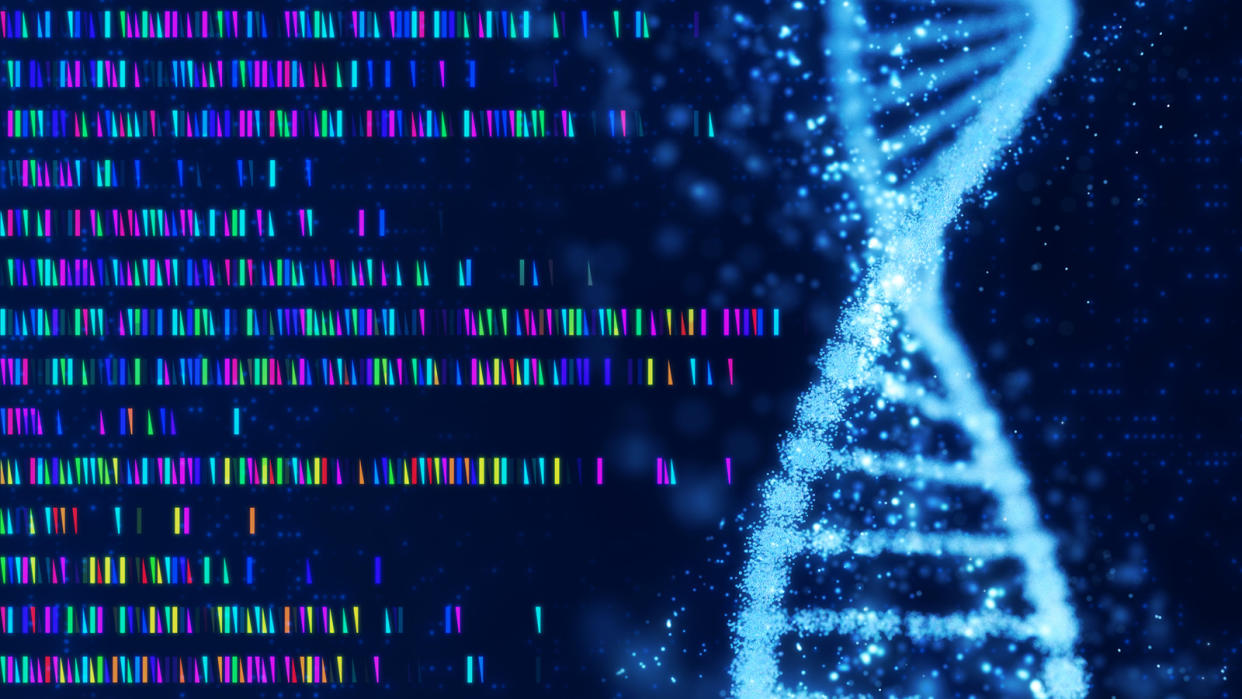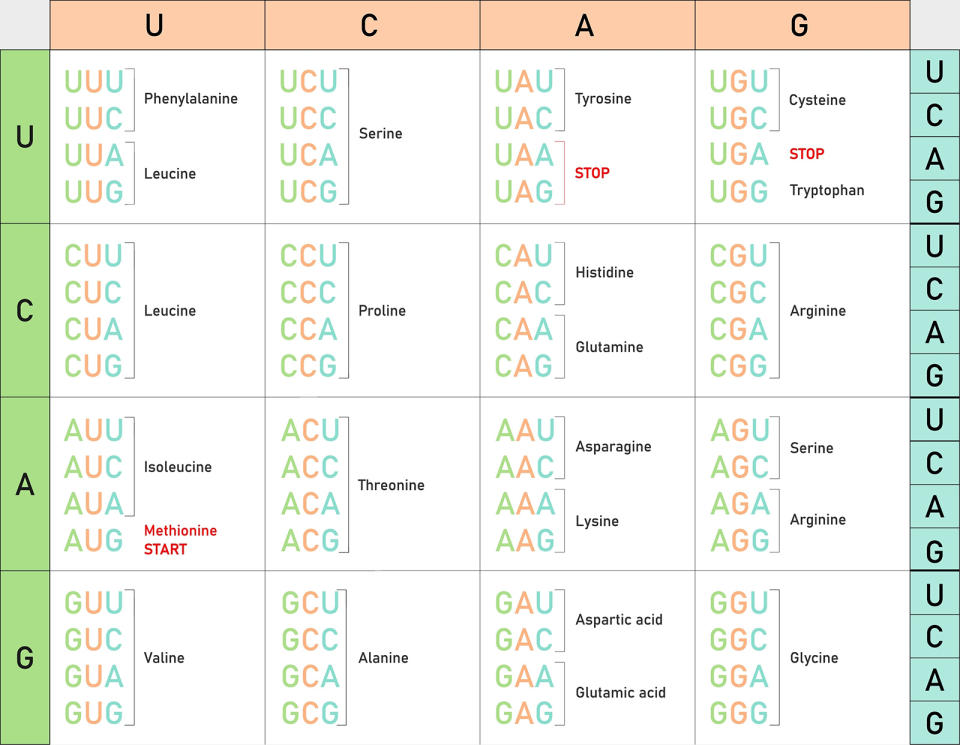Reading a Codon Chart and Identifying Amino Acids

If you're studying genetics, molecular biology or a related field, odds are good that you will need to learn how to read a codon chart (aka codon table) to better understand the genetic code.
This type of chart displays all the possible codons — essential components of DNA and RNA molecules — and the amino acids they represent. By using a codon table, you can translate genetic information into specific proteins. Let's take a closer look at how it all works.
The Genetic Code and Codons
To understand how to use a codon table, it's necessary to first know some basics about genetics.
The genetic code is the set of rules by which the information encoded in genetic material (DNA or RNA) is translated into proteins by living cells. This genetic code is universal, meaning it is consistent across all organisms, from bacteria like E. coli to complex eukaryotes. (Eukaryotic cells contain a nucleus surrounded by a membrane).
The genetic code is represented by codons, with every codon consisting of three nucleotides (a specific type of organic molecule). To represent the different nucleotides in each one of these triplet codes, scientists use the letters U, C, A and G, which stand for uracil, cytosine, adenine and guanine — the four possible nucleotides in messenger RNA.
For example, a sequence for an mRNA molecule might be: AUG-GGU-CAA-UAA. Each one of these codons corresponds to a specific amino acid.
Because there are four possible nucleotides, there are 64 possible codons.
What Is a Codon Chart?
A codon chart is a visual representation that maps each of the 64 codons to their corresponding amino acids or signals. There are two common versions of codon charts, or codon tables. One is a square or rectangle, and the other is a circle.
A codon table is crucial for decoding an mRNA sequence into a chain of amino acids, which are the building blocks of proteins.

Specific Codons and Their Corresponding Amino Acids
Using a codon table, you can determine which codons correspond to which amino acids and vice versa. For example:
The amino acid asparagine (Asn) corresponds to AAU and AAC.
The amino acid glutamine (Gln) corresponds to CAA and CAG.
The amino acid glycine (Gly) corresponds to GGU, GGC, GGA and GGG.
The amino acid methionine (Met) is coded by AUG.
The amino acid phenylalanine (Phe) is coded by the codons UUU and UUC.
The amino acid proline (Pro) corresponds to CCU, CCC, CCA and CCG.
The amino acid valine (Val) is represented by GUU, GUC, GUA and GUG.
Multiple Codons and Redundancy
The genetic code exhibits redundancy, where multiple codons encode the same amino acid. For example, GCU, GCC, GCA and GCG all code for alanine. Since a change in the third nucleotide often does not alter amino acids, this redundancy is a safeguard against genetic mutations.
How to Use a Codon Chart
If you know how to read a codon chart, you can determine which amino acids are encoded in a DNA sequence. Here are the steps:
Identify the mRNA sequence. An mRNA sequence is a series of codons you transcribe from DNA. Let's refer back to our example mRNA sequence of AUG-GGU-CAA-UAA.
Locate the start codon. The start codon is typically AUG, which stands for methionine, and signals the beginning of that particular protein synthesis sequence.
Translate the codons into amino acids. Using the codon table, decode each subsequent codon into the corresponding amino acid.
End at the stop codon. Translation continues until you encounter a stop codon (UAA, UAG or UGA), signaling the end of the protein synthesis sequence.
Origins of the Codon Table
The codon chart originated in the groundbreaking work of mid-20th century molecular biologists. The discovery of the double helical structure of DNA by James Watson and Francis Crick in 1953 set the stage for understanding how genetic information is encoded and translated into proteins.
In the early 1960s, Marshall Nirenberg (who would later receive a Nobel Prize for his work on the genetic code) and Johannes Matthaei conducted experiments using synthetic RNA to direct the synthesis of proteins in cell-free systems.
The men's work demonstrated that specific codons correspond to specific amino acids, leading to the first deciphering of a codon (UUU for phenylalanine). This breakthrough laid the foundation for the complete codon table.
Further research by Nirenberg, Philip Leder, Har Gobind Khorana and others expanded this initial discovery. Khorana's work, particularly his use of synthetic RNA molecules with defined sequences, was instrumental in determining the assignments of the remaining codons.
By 1966, scientists had fully deciphered the genetic code, revealing that most amino acids are encoded by more than one codon, a property known as redundancy or degeneracy.
Significance in Biology and Medicine
In molecular biology, the codon chart has enabled scientists to explore the mechanisms of gene expression, regulation and mutation, allowing for comparative studies across species. And in medicine, it helps scientists and doctors advance genetic research and develop therapeutic interventions.
In genetic science, the codon chart enables the modification of genes for researchers who are studying disease mechanisms or producing therapeutic proteins. For instance, recombinant DNA technology, which relies on the codon chart, has led to the production of insulin, growth hormones and other biologically important substances.
The chart is also crucial in the development of gene therapy, where doctors correct or replace faulty genes to treat genetic disorders.
Understanding codons also helps scientists design mRNA vaccines, such as those that researchers developed for COVID-19. By optimizing the codon sequences for efficient protein expression in human cells, scientists can better ensure a vaccine's effectiveness.
We created this article in conjunction with AI technology, then made sure it was fact-checked and edited by a HowStuffWorks editor.
Original article: Reading a Codon Chart and Identifying Amino Acids
Copyright © 2024 HowStuffWorks, a division of InfoSpace Holdings, LLC, a System1 Company


